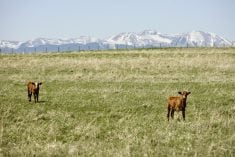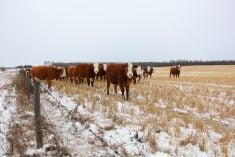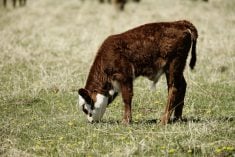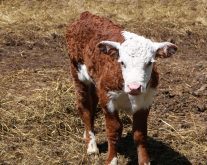For beef producers, calving season can be both stressful and enjoyable. Witnessing new life can be refreshing, but calving time is the most critical period in the cow-calf production cycle. Whether or not calving season is a success will set the tone for an operations’ entire year or longer, having an impact on animal health, farm finances and future reproduction.
Surveys have shown that many farmers are shifting away from confined calving in winter or early spring, and toward extensive calving out on pasture in later spring or summer. However, there are a variety of real-world calving systems in place and there is no “right” way to time calving because it depends on individual farm goals and circumstances.

Dr. Klea-Ann Wasilow is one of three veterinarians operating out of Maple Creek Veterinary Services, serving a mixed animal clientele in both Saskatchewan and Alberta. She says calving season is dictated by many factors.
“The reality of it is in every single operation; there are a lot of moving parts,” Wasilow says, adding that farmers have to balance animal well-being, financial responsibilities and off-farm considerations when planning for calving.
Dr. Mac Littlejohn practices out of a Kirkton, Ont.-based mixed animal clinic and sees various calving systems from grass calving to operations that rely on housing.
“In my personal opinion, I love calving cows on sand or pasture,” says Littlejohn, but adds that each time of year offers its own set of risks and rewards.
Read Also

Body condition, nutrition and vaccination for brood cows
One of the remarkable events of the past century related to ranching has been the genetic evolution of brood cows….
Confined calving has ups and downs
“In our part of the world, for calving indoors there are probably a lot of purebred guys that will calve early because they want those bulls to be a certain age and size by sale,” says Littlejohn.
Commercial operations may choose to calve early in hopes of having better weights in the fall or aim to target an earlier market before the majority of calves hit the sales ring.
“Depending on what their end goal is for the animal, they’re going to have better weaning weights. If those animals are replacement heifers, they’re going to be a better size for breeding season,” he says.
An advantage of calving in confinement is that herds are easy to monitor in case there are issues that require intervention either during calving or shortly after birth.

“Some guys will have closed circuit cameras where they have a camera in the calving pen or area of the barn,” Littlejohn says. When cattle are in pens, struggling newborn calves that are closely supervised can be identified and supported. Those first few moments after birth dictate a lot, and ensuring calves get adequate colostrum, or are supplemented when they are deficient, is essential.
“If that calf’s head isn’t up, if it is having trouble breathing because of its position or orientation coming out of the birth canal, you have the opportunity to give it a jumpstart,” he says.
For producers calving in confinement, disease pressure is the biggest challenge, Littlejohn says. Diseases such as scours need to be proactively managed with a thorough vaccination program and regular, fresh bedding.
“When it comes to scours, environmental hygiene is paramount,” he says. Littlejohn says a good way to tell if you have adequate straw in your calving pen is whether you can drop to your knees while wearing your Sunday best and still have dry pants.
“Calves won’t scour unless they swallow manure. Cows need to be clean so when calves grab a teat, they don’t grab a ball of manure instead,” says Littlejohn. “I’m adamant about vaccinating cows with a scour vaccine. The vaccine focuses antibodies in colostrum against those pathogens.”
Weather can also be a challenge. Littlejohn says farmers should try to keep the barn as close to the outdoor temperature as possible and open it up for ventilation to avoid excess humidity which can cause pneumonia.
“Calves need to be dry and out of the draft,” he says. “The thermoneutral zone for a calf under a month of age is 10 degrees Celsius.” When the temperature drops below that, the calf is burning energy simply to keep its body temperature where it should be.
Pasture calving takes planning
Like many regions across Canada, Wasilow’s practice serves a clientele that is growing older, yet still maintaining a large herd with perhaps fewer helping hands. She says a lot of her clients have transitioned to calving on grass in later spring because it is less labour intensive.
In addition, many producers prefer to calve when the grass is green to optimize their nutrition. “You can spend less time and energy feeding some of those early lactation cows because we already have the grass.”
A major advantage to extensive calving is reduced exposure to diseases simply because cattle are spread out across larger areas. “There is less contact time, less accumulation of pathogens and more opportunity for separation of groups,” Wasilow says.
Some ranchers use the Sandhills system, moving pregnant cows onto clean ground away from pairs. “Other producers have a bigger calving area and as they’ve calved and mothered, they’ll pair out into small bunches,” she says.
A lot depends on manpower and how the operation is logistically set up with pastures and water. She notes some producers may be in community pastures and that can play a role in how pairs are moved as they calve.
How can producers best prepare for calving out on the range? Wasilow says that is a year-long conversation. Using good genetics and having a robust herd are helpful. However, extensive calving comes with its share of risks.
“Something we consistently run into is when we’re calving in these types of systems, we are less prepared for inclement weather,” she says, explaining that when pairs are spread out over large acreages, it can be a challenge to rally the troops. “If a weather event does arrive, there’s potential for it to cause calf losses or a disease event that happens from crowding from those events.”
If a bad storm is coming, producers can do their best to prepare by providing extra shelter and straw to help cattle bed down. “If you have a weather event, as soon as it’s under control or passed, get out there and put the time and effort to really check, not just on the group but on individuals and those new babies. Focus on them,” Wasilow says.
Assisting cows or supporting newborn calves out on pasture are both a pro and a con.
“It’s less convenient to intervene but we have to intervene less,” Wasilow says. “When they’re calved out on pasture, we see less dystocia, cows tend to be more active, in better shape, physically fit, not as heavy, and so we have less issues.”
On the flip side, if there is a problem, those cows can be harder to help, and will often hide in a creek or draw. By the time producers get an opportunity to intervene, there sometimes is no chance for a positive outcome if that cow has been calving for an extended period.
Making the move
Making the decision to transition your calving season should not be taken lightly. Littlejohn says a good place to start is having a proactive conversation with your vet.
“Vets typically see beef farms twice a year, in the fall at preg-checking or in the spring during semen testing, or whenever there’s a problem or outbreak,” he says. “It’s always good to have a discussion with your vet on what you did last year, what was your timing, how did calving season go, what do we need to change or tweak.”
For producers considering a shift, Wasilow encourages them to ask questions, do their research and engage with professionals.
“They should sit down with their accountant who should be able to help look at markets and see what their economic impact will be,” she says. “If I calve six weeks later, what would the market difference be like in the last two years?”
Littlejohn says the most effective producers seek insight from experts including bankers and industry specialists. “Their successes will guide your successes.”
Wasilow points to logistical considerations that a calving season shift may result in, including a need for any facility or infrastructure adjustments. “Are there things that should be in place before the switch or within the same year?” she asks.
Producers need to think about their whole calendar year and look at how pushing calving back can affect other important dates like branding, processing, community pasture take-in dates and sale days.
“A lot of time we have a traditional rhythm with each ranch,” she says, and producers need to assess whether a transition is truly a benefit to them.
When it comes to choosing a calving season, there is no single right answer. “Keep asking questions,” Wasilow says. “You have to do what works for you. Every operation has a unique set of circumstances.”
















